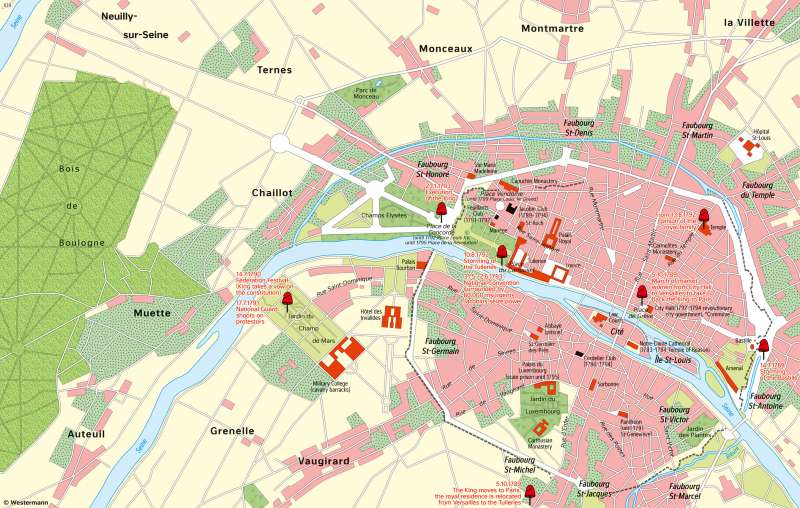Paris - During the time of the French Revolution
Turn of an Era
978-3-14-100890-6 | Page 92 | Ill. 2

Overview
The French Revolution began in Paris and spread rapidly. When angry crowds stormed the Bastille, the state prison located in the east of Paris, on 14 July 1789, they gave the starting signal for the French Revolution.
Sites of the French Revolution in Paris
There is more to mention than just the fortress Bastille in the eastern part of the old city. In October 1789, the royal family, which until then had resided in Versailles, was imprisoned in the Tuileries Palace in the west of the city. Opposite, in the royal riding hall, the Manège des Tuileries, the National Constituent Assembly met from 1789, the National Legislative Assembly from 1791 and the National Convention from 1792. Various party-like groups such as the Jacobin Club or the Cordeliers Club met in the expropriated convents in the centre. The National Convention and the Committee of Public Safety had their headquarters in the Tuileries. The Paris City Hall (Hôtel de Ville) served as the seat of the revolutionary city administration (Commune), and Notre-Dame Cathedral was renamed the "Temple of Reason". The Palais Luxembourg, once a residence of the royal family, became a state prison from the early 17th century, after its expropriation. After the Tuileries storm in August 1792, Louis XVI and his family were transferred to the Temple, originally a foundation of the Order of the Knights Templar. At the time of the Committee of Public Safety, which became the organ of the Jacobin reign of terror under Maximilien de Robespierre (June 1793 to July 1794), the King, Queen Marie Antoinette and over 1100 other people were executed by guillotine in the Place de la Concorde (then: Place de la Révolution, see picture on the top). The last ones were Robespierre and his comrade-in-arms Saint-Just (28 July 1794). The revolution ended in September 1795 with the proclamation of a new constitution by the Directory government. On 9 November 1799 Napoleon replaced the Directory, which had been weakened by royalist and other uprisings, in a coup d'état. His self-exaltation as First Consul marked the beginning of the Napoleonic era. The 3 phases of the revolution and its executive as well as legislative powers are summarised in the diagram below.




